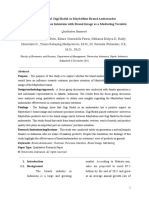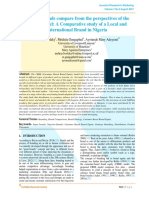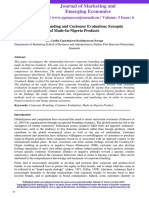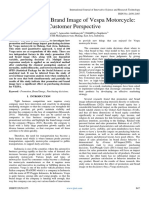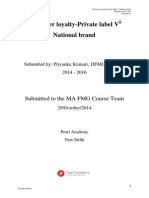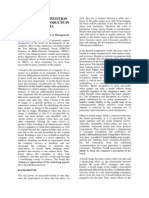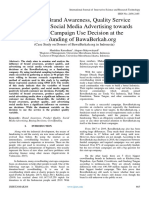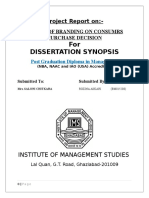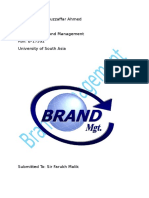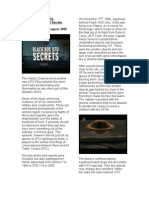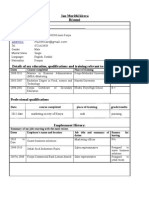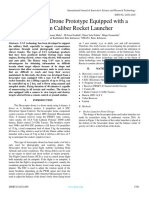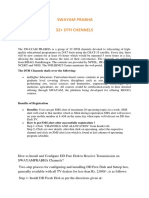Professional Documents
Culture Documents
The Effect of Brand Awareness Used by FMCG's Manufacturers in Improving Support of Local Products A Zambian Perspective
Original Title
Copyright
Available Formats
Share this document
Did you find this document useful?
Is this content inappropriate?
Report this DocumentCopyright:
Available Formats
The Effect of Brand Awareness Used by FMCG's Manufacturers in Improving Support of Local Products A Zambian Perspective
Copyright:
Available Formats
Volume 7, Issue 7, July – 2022 International Journal of Innovative Science and Research Technology
ISSN No:-2456-2165
The Effect of Brand Awareness Used by FMCG’s
Manufacturers in Improving Support of Local
Products: A Zambian Perspective
Burton Mweemba1
ZCAS University, School of Business
Lusaka, Zambia. Boyd Longwe4
ZCAS University, School of Business
Professor Edwin Bbenkele2 Lusaka, Zambia.
ZCAS University, School of Business
Lusaka, Zambia. Windu Matoka5
ZCAS University, School of Business
Gwebente Mudenda3 Lusaka, Zambia.
ZCAS University, School of Social Sciences
Lusaka, Zambia.
Abstract:- Many countries have created buy local with this position on branding stating that a brand is anything
campaigns to encourage local customers to become that brings uniqueness to the product or service through a logo,
ethnocentric towards local brands. In order to enhance the name, signs, color, terms or designs that differentiates the
buy local campaign’s effectiveness, many countries have product from competitors. Branding builds an emotional
created a logo to be used by all campaign members. The connection between an organization and customers. Branding
motivation to develop buy local campaigns by many states has the ability to change the purchase intentions of customers
has been to improve the economies and create as it also fosters the emotional connection between the product
employment. Zambia unemployment rate has been on a and the customer. Aaker (1991[2]) states that brand equity is
rise at 20.17% in 2020, hence the need to improve local determined by how customers view a brand in terms of brand
brand advocacy. Quantitative research was conducted associations, brand loyalty, name recognition, perceived
which involved the sample size of 295, and the data was quality, and other proprietary brand assets.
collected using a questionnaire and data analysis was done
using SPSS to produce the descriptive information. Problem Statement
The results indicate that many respondents were not aware The Zambian market are inundated with a mixture of
of the logo used by the buy local campaign, as there is more products from both local and international markets out of
than one logo used by the industry players. The results also which citizens are fronted with a challenge of choice as to
show that the majority of respondents prefer buying which product they would select at a particular time, and this
imported products other than the local FMCG’s. This is supposedly driven by patriotism, ethnocentrism and
therefore renders the branding strategy used by the buy intentionality. World Bank (2015[3]) states that a significant
local campaign ineffective. There is need for all industry number of FMCGs in Zambia are imported from other
players to use one logo as branding brings emotional countries such as South Africa (SA) and Zimbabwe. Further,
connection between the products and the customers. Ziba and Phiri (2017[4]) also posit that about 80% of FMCG’s
sold in Zambia, especially from one of the leading retail outlets
Keywords:- Branding, Brand equity, FMCG’s, Perceived like Shoprite Zambia, Pick N Pay are mainly imported from
quality, Positioning. South Africa. Faced with a heavy influx of imported products
from South Africa, branding is one of the important elements
I. INTRODUCTION that might influence the support of local FMCG’s. As Zambia
is importing 80% of FMCG’s, the rate of unemployment is
When evaluating the effectiveness of marketing arguably said to have reached an alarming level of 12.17% in
promotional tactics, branding is one of the factors taken into 2020, 13.20% in 2019 from 11.40% in 2018 (Zamstat,
account. With the passage of time, the definition of branding 2020[5]). The question is, how effective is the branding
has changed, including the understanding. Branding should be strategy used to support the buy local campaign in Zambia?
understood to be beyond just identifying and differentiating a
product or service from those of competitors. Weinewski Objectives
(2011[1]) defines branding as all things that has to do with the To identify the branding strategy used by manufacturers of
whole organization which includes the tangibles and FMCG’s in support of the buy local campaign.
intangible attributes of the firm. A brand could be everything
about an organization which can include the logo, the product,
the name, what the company believes in, what you say, what
you do and how the product looks like. Aaker (1991[2]) agrees
IJISRT22JUL1005 www.ijisrt.com 1184
Volume 7, Issue 7, July – 2022 International Journal of Innovative Science and Research Technology
ISSN No:-2456-2165
To establish the influence of branding strategy used by the B. The value of branding to customers
Proudly Zambian Campaign to attract support from local The perceived value of the brands by the targeted
consumers. consumers also influences the success of promotional efforts.
The notion of branding, according to Kotler and Keller
II. LITERATURE REVIEW (2016[9]), has the potential to effectively developing mental
structures that boost the consumer's ability to gather enough
De Charnatony, McDonald, & Wallace (2011[6]) brand information or knowledge about the items and services. When
is just a collection of emotional and functional values that clients have the ability to readily recognize their favorite
firms employ to develop their promises to customers about goods, De Charnatony, McDonald, & Wallace (2011[6])
what they are delivering and the distinctive experience they asserts that this minimizes the cost of searching and further
should have. Coleman (2011[7]) described branding as a eliminates the risks in the purchasing process.
concept that helps offer value to consumers through the
facilitation of reciprocal advantages between the buyer and the According to Chrostodoulides and De Chernatony
supplier, which is largely founded on passionate and (2009[10]), consumers of products usually identify with the
purposeful values. product's symbolic device, perceived quality, and function in
meeting the customer's wants. According to Chovanova,
According to Karan and Saydam (2015[8]) a brand Korshunov, and Barbcanova (2015[14]), branding serves as a
provides an emotional reason for why a consumer should buy memory cue for customers, allowing them to recall key
a certain product or service. According to Kotler and Keller information and make an informed purchase decision.
(2016[9]), a brand is all a product means to customers. As a According to Alizade, Hoseini, and Naiej (2014[15]) branding
result, a brand should refer to everything that adds value to as a concept also involves effective communication,
consumers. From the positive image built for the product value positioning, personality, and value identity. Allaway,
is built and this increases brand recall and hence brand loyalty. Huddlestone, Whipple , and Ellinger (2011[16]) suggest that
Ultimately from the brand associations made by consumers the information acquired could be about the customers' brand
this creates brand equity for the firm, employees and experience, brand association, and brand image. If a
consumers (Aaker, 1991[2]). corporation wants to succeed, especially in a competitive
business environment, it has been suggested that branding is
A. The logos as brand element used by manufacturers in the most crucial element of the business strategy Allaway,
support of buy-local campaigns Huddlestone, Whipple , and Ellinger (2011[16]).
According to Salehudin (2016[11]), buy local campaigns
in different nations have chosen different symbols. Customers C. Considering brand equity in the buy local campaign
will be able to relate to the brands more easily as a result of In all notable definitions, brand equity is thought to be a
this. This creates brand awareness and the needed brand recall. factor that contributes to increased profits, improved
As part of these campaigns, governments typically produced a communications, and brand expansion opportunities, as well
logo to show that a commodity is local to that country. The as enhancing consumers' preferences and intentions to buy a
logo is frequently encouraged to be used on products by local specific product, which affects customer loyalty Allaway,
businesses (Saffu, Walker, and Mazurek (2010[12]). Huddlestone, Whipple , and Ellinger (2011[16]). According to
Chrostodoulides and De Chernatony (2009[10]) the idea of
According to Alter, Bridger, and Frumento (2012[13]), brand equity covers how customers think, feel, and react to
manufacturers are expected to support purchase local brand messages such as price, product or brand needs, product
initiatives by utilizing the agreed-upon logo to help local profitability, customer base, and market share.
businesses thrive. Here are some logos that have been used in
purchase local campaigns (Indonesia, Australia, United D. Customers and company brand equity
Kingdom, South Africa, and Zimbabwe). Aaker (1991[2]) suggests that there are three types of
brand equity namely, consumer based brand equity, employee
based brand equity and firm based brand equity. Researchers
have mostly examined and analyzed brand equity from two
perspectives: customer brand equity and corporate brand
equity perspectives Chrostodoulides and De Chernatony
(2009[10]). Customer-based brand equity, as espoused by
Chrostodoulides and De Chernatony (2009[10]) is based on
customers' perceptions of the value they receive from the
brand, whereas firm-based brand equity is based on the firm's
capacity to influence product demand, grow market shares,
and profitability. Keller (2013[17]) posits that the customer-
based brand equity method, measures customers' thinking,
brand image, how they perceive the brand, beliefs, and how
they feel about the brand, as well as how they react to brand
Fig 1 communications.
IJISRT22JUL1005 www.ijisrt.com 1185
Volume 7, Issue 7, July – 2022 International Journal of Innovative Science and Research Technology
ISSN No:-2456-2165
Chinomona and Maziriri (2017[18]) conducted a study in determinants of consumer brand success. With the
South Africa, and discovered that brand trust, familiarity, and achievement of this success the resulting brand loyalty would
experience had a favorable effect on customer brand create value for the firms in terms of profitability. Huang and
attachment, which enhanced the support of the proudly South Sarigollu (2012[25]), investigated how brand awareness
African campaign. According to Laforet (2010[19]), today's connects to market result, brand equity, and the marketing mix
customers don't consume or buy products but buy brands, and in their study by combining survey data with real-market data.
this ranges from convenience products to high involvement As a measure of brand market performance, the study looked
products like clothing. Roustasekehravani and Hamid at increases in brand sales and market share. To see if brand
(2014[20]) postulate that if brands are well managed, a firm's awareness is an antecedent of market outcome, the researchers
market share and profitability would improve. utilized regression and cross-prediction studies. According to
Huang and Sarigollu (2012[25]), study, they found that brand
Hence, a well-executed Buy Local campaign, such as the awareness and brand market performance are linked. This
Proudly Zambian campaign, would increase brand trust and would suggest that if the Zambia Buy Local Campaigns are
familiarity in the local market. This would result into increased successful the market demand for local products would be high
demand for the local products thereby sustaining and that is the ultimate goal of these campaigns.
manufacturing and contributing to employment creation.
Customers who are made loyal to a brand as a consequence of Kim and Kim, (2013[29]) found that brand awareness
effective branding are always willing to spend more because has a positive relationship with market performance in the
of the company's trust and quality Ahmed, Rizwan, Ahmad, hotel industry, and that substantial differences in brand
and Haq (2014[21]). awareness exist between high and low market performance
hotels in other similar studies of the relationship between
E. Buy local campaign brand awareness brand awareness and brand performance. Baldauf, Cravens,
Brand recognition is the most important and first feature and Binder, 2013[30]) investigated the impact of brand equity
of consumer brand equity, and it is frequently overlooked as a management on the tile industry's sales and profit performance
component of brand equity Tong and Hawley (2009[22]). It's results in another study. The study discovered a substantial
a key indicator of a customer's brand awareness, the frequency link between brand awareness and brand sales and
with which the brand appears in their minds, and the ease with profitability. Many researchers have studied the impact of
which that knowledge may be recalled from memory branding on customer purchase intention in other countries
(O’Guinn, Allen, and Semenik, 2009[23]). If consumers are such as Ghana and South Africa (Darku and Akpan, 2020[27]).
aware of a company's product or service, they are more likely However, there is still a gap in knowledge as branding used by
to accept its presence and availability (Mowen and Minor, the buy local campaign is yet to be appreciated in Zambia.
2011[24]). According to Huang and Sarigollu (2012[25]),
brand recognition comes before brand equity in the III. METHODOLOGY
perspective of customers.
Langos (2004[31]) defined methodology as the structure
There are two types of brand awareness: aided or assisted related with a specific arrangement of paradigmatic
awareness and top of mind awareness (Farris, Bendle, Pfeifer, suppositions that one uses to conduct a study, for example, the
and Reibstein, 2010[26]). When a customer is presented a scientific method, ethnography and activity research. For this
variety of brand names and must choose one from a list, aided study, the researcher used a survey. According to Check and
recognition occurs, whereas 'top of mind awareness' occurs Schutt (2012[32]), survey research is the collection of
when the brand name is immediately recognized since the information from a sample of individuals gotten from a large
consumer easily correlates the brand with the product category population. For this study, the population of interest was the
Keller (2013[17]). consumers of FMCG’s in Lusaka. The questionnaire was used
to collect the data. Data analysis was conducted using SPSS to
Despite the fact that individuals in Ghana did not seem come up with descriptive information.
to be as aware of the local campaign (branding) as they did in
South Africa, Darku and Akpan (2020[27]) discovered that the A. Sampling Strategy
Ghanaian campaign was more popular. On a scale of "strongly Sampling is a process of choosing a representative group
agree" to "strongly disagree," respondents were asked to rate of people or items from the population of interest in order to
their level of awareness, with lower mean scores indicating generalize the findings (Etikan and Bala, 2017[33]). For this
higher awareness. The average awareness score in both study, the researcher used probability (systematic) sampling
campaigns was 3.14. South Africa had a lower awareness level method, of which quantitative data was collected from
than the rest of the world (2.18), whereas Ghana had a higher consumers of FMCG’s in Lusaka District of Zambia. The
awareness level (4.05). sample involved 295 respondents.
F. Brand awareness and brand performance in the market
Kilei, Iravo, and Omwenga (2016[28]) investigated the
impact of brand awareness on product and service market
brand performance. Brand recall and brand recognition were
found to be positively and significantly related, suggesting that
brand recall and overall brand knowledge are critical
IJISRT22JUL1005 www.ijisrt.com 1186
Volume 7, Issue 7, July – 2022 International Journal of Innovative Science and Research Technology
ISSN No:-2456-2165
IV. DATA ANALYSIS AND RESULTS V. CONCLUSION
A. The FMCG’s customers prefer According to the findings, the respondents were unaware
of the campaign's branding strategy. Many respondents
Table 1: Brand Preferences (48.6%) expressed a lack of knowledge about the logo brand
element used in the buy local campaign used in Zambia. Local
campaigns in different countries have adopted different
symbols Salehudin (2016[11]). Customers will be able to
easily relate to the brands as a result of this. MCTI (2018[35])
states that more than one logo has been used as an identifier in
support of the buy local campaign.
Table 1 above shows the descriptive statistics on which
FMCG’s the consumers buy the most. 61 out of 292
respondents representing 20.9% prefer buying local brands
and 231 out of 292 respondents representing 79.1% prefer
buying foreign or imported FMCG’s. According to the study
by Van den Berg (2017[34]) in South Africa, 24% of the
respondents strongly disagreed to a statement that buying
foreign brands is un- South African, 38% disagreed and 24% Fig 2: Logos for Buy local in Zambia
neither disagreed nor agreed. Both studies seem to show that
consumers in both countries support imported brands as According to Darku and Apkan (2020[27]), the buy
compared to local FMCG products. South African campaign adopted only one logo that it is
associated with. The usage of a well-known logo makes it
B. Branding strategy (Logo) used to support the the buy local easier for buyers to recognize and recall the products and
campaign would easily help customers become ethnocentric
(Chovanova, Korshunov, and Barbcanova, 2015[14]). The
Table 2: Logo used for branding usage of a logo help to strengthen the campaign's
identification. The logos used by industry players in Zambia
as evidenced by figure 2 above where there is more than one
logo might be confusing to local buyers. The industry players
should begin using the one agreed logo in support of the buy
local campaign. Results indicate that the majority of
respondents have challenges recognizing the logo used to
support the campaign, therefore, this confirms that the
branding strategy is not effective.
REFERENCES
[1]. Weinewski, M. (2011). Why Invest In a Brand? Non
The descriptive findings of the branding strategy (logo) Profit World, 29(3).
used by the buy local campaign are shown in the table above. [2]. Aaker, David A. (1991), Measuring Brand Equity Across
3.1% strongly agreed that the campaign has a specific logo that Products and Markets, California Management
can be seen, and 21.6% strongly agreed that the buy local Review, 38, 3, 102-120
campaign has a specific logo that can be seen in Zambia. [3]. World Bank (2015). World integrated trade solutions.
20.2% neither agreed nor disagreed, 6.5% disagreed and Lusaka: World Bank. Retrieved from
48.6% strongly disagreed. This shows that Zambian https://www.wider.unu.edu/sites/default/files/Publicatio
consumers are not aware of the Buy Local logo. If this is the ns/Working-paper/PDF/wp2017-58_0.pdf
case then it would suggest that the campaign is failing to create [4]. Ziba, F., & Phiri, M. (2017). The Expansion of regional
the needed awareness needed to change behavior. Saffu, Supermarkets chains. Lusaka: United Nations World
Walker, and Mazurek, 2010[12]) argued that in order for a buy Instistitute for Development Economics Research.
local campaign to be successful, a common logo must be used Retrieved from
to solicit support from local buyers. According to Darku and https://www.wider.unu.edu/sites/default/files/Publicatio
Akpan (2020[27]), the buy South African campaign has a ns/Working-paper/PDF/wp2017-58_0.pdf
distinct message and a well-known logo that is used by all [5]. Zamstat. (2020, April Thursday). Zambia Statistics
manufacturing members. According to a study by Salehudin Agency. From Zambian unemployment rate:
(2016[11]), the Indonesian government has approved the use https://www.zamstats.gov.zm/
of one logo in the buy local campaign to represent that the
product is native.
IJISRT22JUL1005 www.ijisrt.com 1187
Volume 7, Issue 7, July – 2022 International Journal of Innovative Science and Research Technology
ISSN No:-2456-2165
[6]. De Charnatony, L., McDonald, M., & Wallace, E. [22]. Tong, X., & Hawley, J. M. (2009). The measuring
(2011). Creating Powerful Brands (4 ed.). Oxford: customer-based brand equity: An empirical evidence
Taylor & Francis Ltd. from the sportswear market in China. Journal of Product
[7]. Coleman, D. (2011). Servive Brand Identity: Definition, and Brand Management, 18(4), 262-271.
Measurement, Dimensionality and Influence on Brand [23]. O’Guinn, T., Allen, C. T., & Semenik, R. J. (2009).
Performance. London: PhD Thesis, University of Advertising and integrated brand promotion (5 ed.).
Birmingham. South-Western, Mason: OH.
[8]. Karam, S., & Saydam, S. (2015). An Analysis Study of [24]. Mowen, J., & Minor, M. S. (2011). Consumer behaviour:
Improving Brand Awareness and Its Impact on A framework. Upper Saddle River: Prentice Hall.
Consumer Behavior Via Media in North Cyprus (A Case [25]. Huang, R., & Sarigollu, E. (2012). How brand awareness
Study of Fast Food Restaurants). International Journal relates to market outcome, brand equity, and the
of Business and Social Science, 6(1), 66-80. marketing mix. Journal of Business Research, 65, 92-99.
[9]. Kotler, P., & Keller, L. K. (2016). Marketing [26]. Farris, P., Bendle, N. T., Pfeifer, P. E., & Reibstein, D. J.
management (15 ed.). Pearson Education. (2010). Marketing Metrics. Upper Saddle River:
[10]. Chrostodoulides, G., & De Chernatony, L. (2009). Pearson.
Consumer Based Brand Equity Conceptualization and [27]. Darku, E., & Akpan, W. (2020). Selling culture: A buy
Measurement. International Journal of Market local campaigns in the Ghanaian and South African
Research, 52(1), 43-66. textile and clothing industries. Journal of Enterprising
[11]. Salehudin, I. (2016). The Role Of Government To Communities, 14(4), 643-662.
Promote Local Products. Asean Marketing Journal, 8(1), [28]. Kilei, P., Iravo, M., & Omwenga, J. (2016). The Impact
6. Of Brand Awareness On Market brand performance of
[12]. Saffu, K., Walker, J. H., & Mazurek, M. (2010). The service brands: Contextual consideration of Kenya’s
Role of Consumer Support In The Buy Local Campaign banking industry. European Journal of Business and
In a Developing Country. The International Journal Of Management, 8(18), 92-103.
Emerging Markets, 5(2), 203-226. [29]. Kim, H., & Kim, W. G. (2013). The effect of consumer
[13]. Alter, T. R., Bridger, J. C., & Frumento, P. Z. (2012). based brand equity on firms financial performanace.
Supporting rural entreprenuership: Institutional and rural Journal of Consumer Marketing, 20(4), 335-351.
strategies for community and economic development. [30]. Baldauf, A., Cravens , K. S., & Binder, G. (2013).
Journal of Economic Development, 12(1), 93-108. Performance consequences of brand equity management
[14]. Chovanova, H., Korshunov, A. I., & Barbcanova, D. evidence from organization in the value chain. Journal of
(2015). Impact of Brand on Consumer Behaviour. Product and Brand Management, 12(4), 220-236.
Journal of Economics and Finance, 34(1), 612-621. [31]. Langos, S. (2004). Research Methodology: Data
[15]. Alizade, M., Hoseini, A., & Naiej, K. A. (2014). The collection method and research tools. 3rd IEEE
Comparison of Product and Corporate Branding International Conference on Computing, Electronics &
Strategy: A Conceptual Framework. Journal of Business Communications Engineering 2020 (pp. 124-130).
and Management, 16(1), 14-24. London: University of Essex.
[16]. Allaway, A., Huddlestone, P., Whipple , J., & Ellinger, [32]. Check, J., & Schutt, R. K. (2012). Research methods in
A. E. (2011). Customer based brand equity, equity Education. Thousand Oaks: Sage Publications.
drivers and customer loyalty in the supermarket industry. [33]. Etikan, I., & Bala, K. (2017). Sampling and sampling
Journal of Product and Brand Management, 20(3), 190- methods. Biometrics and Biostatistics International
204. Journal, 5(6), 215-222.
[17]. Keller, K. (2013). Strategic brand management: [34]. Van den Berg, A. (2017). Factors influencing the
building, managing and measuring the brand equity (4 purchasing intention of the black middle class in
ed.). England: Pearson Education. emerging markets for the global brands. University of
[18]. Chinomona, E., & Maziriri, T. (2017). The Influence of Witwatersrand.
Brand Trust, Brand Familiarity and Brand Experience on [35]. MCTI. (2018). National Local Content Strategy. MCTI,
Brand Attachment: A Case. Journal of Economics and Domestic Trade. Lusaka: Govt Printers. Retrieved
Behavioural Studies, 9(1), 68-81. January 2020, from
[19]. Laforet, S. (2010). Managing brands: A contemporary http://www.zda.org.zm/sites/default/files/Local%20Con
perspective. Berkshire: McGraw-Hill. tent%20Strategy%20-%20MCTI.pdf
[20]. Roustasekehravani, A., & Hamid , A. B. (2014). Do
brands personality really enhance satisfaction and loyalty
towards the brand? A review of theory and empirical
research. European Journal of Business and
Management, 6(25), 174-183.
[21]. Ahmed, Z., Rizwan , M., Ahmad , M., & Haq , M. (2014).
Effect of brand trust and customer satisfaction on brand
loyalty in Bahawalpur. Journal of Socialogical Research,
5(1), 306-324.
IJISRT22JUL1005 www.ijisrt.com 1188
You might also like
- The Impact of Gigi Hadid As Maybelline Brand Ambassador On Customer Purchase Intention With Brand Image As A Mediating VariableDocument18 pagesThe Impact of Gigi Hadid As Maybelline Brand Ambassador On Customer Purchase Intention With Brand Image As A Mediating VariableAdinda SalsabilaNo ratings yet
- The Effect of Brand Image and Promotion On Purchasing Decisions and Their Implications For Customer Satisfaction With Aqua Bottled WaterDocument8 pagesThe Effect of Brand Image and Promotion On Purchasing Decisions and Their Implications For Customer Satisfaction With Aqua Bottled WaterInternational Journal of Innovative Science and Research TechnologyNo ratings yet
- Revitalization and Synthesis of Factors Associated With The Purchase of Local Fast Moving Consumer Goods The Zambian PerspectiveDocument7 pagesRevitalization and Synthesis of Factors Associated With The Purchase of Local Fast Moving Consumer Goods The Zambian PerspectiveInternational Journal of Innovative Science and Research TechnologyNo ratings yet
- How Do Brands Compare From The Perspectives of The CBBE Model NIGERIA 2017 Jorm-189-443-1-PbDocument14 pagesHow Do Brands Compare From The Perspectives of The CBBE Model NIGERIA 2017 Jorm-189-443-1-PbIndian TigerNo ratings yet
- The Impact of Brand Awareness On CustomeDocument46 pagesThe Impact of Brand Awareness On Customekwasi BenNo ratings yet
- Corporate Branding and Customer Evaluation: Synopsis of Made-In-Nigeria ProductsDocument18 pagesCorporate Branding and Customer Evaluation: Synopsis of Made-In-Nigeria ProductsOpen Access JournalNo ratings yet
- E-Branding Vaibhav Shukla MBADocument40 pagesE-Branding Vaibhav Shukla MBAsonuji1187100% (2)
- SEMINAR PAPER On GREEN MARKETINGDocument25 pagesSEMINAR PAPER On GREEN MARKETINGAlia SoniNo ratings yet
- Brand Perception - Kao Kveng Hong - Final RevisedDocument9 pagesBrand Perception - Kao Kveng Hong - Final RevisedHong KhengNo ratings yet
- Secondary Objectives: Objectives of The Study Title of The StudyDocument6 pagesSecondary Objectives: Objectives of The Study Title of The StudyAhamed HussainNo ratings yet
- Sutdent Choice For Branded Laptop With Special Foucs On HCL, HP, SONY & LENOVADocument87 pagesSutdent Choice For Branded Laptop With Special Foucs On HCL, HP, SONY & LENOVAsidd_quest8585No ratings yet
- The Effects of Selected MarketDocument11 pagesThe Effects of Selected MarketFelisitas AgnesNo ratings yet
- Branding Corrected - Kiki Owusu CorrectionDocument11 pagesBranding Corrected - Kiki Owusu CorrectionKryz DukeNo ratings yet
- Promotion and Brand Image of Vespa Motorcycle Customer PerspectiveDocument7 pagesPromotion and Brand Image of Vespa Motorcycle Customer PerspectiveInternational Journal of Innovative Science and Research TechnologyNo ratings yet
- Determinant of Purchasing Decision and Loyalty of The Consumer of Wardah Cosmetic Productsin Banda Aceh, IndonesiaDocument8 pagesDeterminant of Purchasing Decision and Loyalty of The Consumer of Wardah Cosmetic Productsin Banda Aceh, IndonesiaShinta Tri NurazizahNo ratings yet
- Internship ReportDocument54 pagesInternship ReportMizanur RahamanNo ratings yet
- Group 8 PDFFFDocument70 pagesGroup 8 PDFFFTrixy RodriguezNo ratings yet
- Iran KhodroDocument9 pagesIran Khodrosaba.ayremiNo ratings yet
- Brand RecallDocument44 pagesBrand RecallRiddhiman MitraNo ratings yet
- Brand AssociationsDocument11 pagesBrand AssociationsLamine BeddiarNo ratings yet
- Customercare-Private Label V/S NationalbrandDocument17 pagesCustomercare-Private Label V/S NationalbrandpriyankamgtNo ratings yet
- The Competitivenes of Brand of Consumer Product in Cambodia - Kao Kveng HongDocument12 pagesThe Competitivenes of Brand of Consumer Product in Cambodia - Kao Kveng HongHong KhengNo ratings yet
- Review On Effect of Branding On Consumer Buying BehaviourDocument10 pagesReview On Effect of Branding On Consumer Buying BehaviourDr Bhadrappa HaralayyaNo ratings yet
- The Effect of Brand Image, Service Quality, Location On Purchasing Decisions of Post-Covid-19 Intervening Trust Cafe (Lampoh Cofee Case Study)Document6 pagesThe Effect of Brand Image, Service Quality, Location On Purchasing Decisions of Post-Covid-19 Intervening Trust Cafe (Lampoh Cofee Case Study)International Journal of Innovative Science and Research TechnologyNo ratings yet
- Product & Corporate Branding Strategy-ComparisonDocument11 pagesProduct & Corporate Branding Strategy-ComparisonsandipgargNo ratings yet
- BrandbuildingofRetailStores MSS - Deepaanddr.pchiramaniDocument17 pagesBrandbuildingofRetailStores MSS - Deepaanddr.pchiramaniswaaaaNo ratings yet
- Brand Awareness of AirtelDocument85 pagesBrand Awareness of Airtelvittamsetty72% (18)
- Consumer Perception of In-House Brands and Local BrandsDocument8 pagesConsumer Perception of In-House Brands and Local BrandssarthakNo ratings yet
- The Impact of Brand Awareness On Custome PDFDocument45 pagesThe Impact of Brand Awareness On Custome PDFSingh Gurpreet100% (1)
- Consumer Perception of In-House Brands vs Local BrandsDocument8 pagesConsumer Perception of In-House Brands vs Local BrandsRiu GulatiNo ratings yet
- Synopsis On: Vishwa Vishwani School of BusinessDocument8 pagesSynopsis On: Vishwa Vishwani School of BusinessswethaNo ratings yet
- Analysis of Brand Awareness, Quality ServiceDocument7 pagesAnalysis of Brand Awareness, Quality ServiceInternational Journal of Innovative Science and Research TechnologyNo ratings yet
- Part NovitaDocument8 pagesPart NovitaNovita HariyaniNo ratings yet
- Brand Management 1Document11 pagesBrand Management 1MAXWELL gwatiringaNo ratings yet
- Impact of Brand On Consumer Buying BehaviorDocument4 pagesImpact of Brand On Consumer Buying BehaviorPRAVEENKUMAR MNo ratings yet
- Building Indian Brands for Global SuccessDocument18 pagesBuilding Indian Brands for Global SuccessSanjay AgarwalNo ratings yet
- BA801116 Lorena (Maz) UKCBC BMDocument23 pagesBA801116 Lorena (Maz) UKCBC BMIsmam Ahmed ApurbaNo ratings yet
- International Institute of Professional Studies Devi Ahilya University, IndoreDocument41 pagesInternational Institute of Professional Studies Devi Ahilya University, IndoreRohit Harjai0% (1)
- Effect of Branding On Consumer Buying BehaviourDocument15 pagesEffect of Branding On Consumer Buying BehaviourRishabh TiwariNo ratings yet
- Brand Loyalty - Customers Buying Behaviour On Soap "With Special Reference To Dove"Document8 pagesBrand Loyalty - Customers Buying Behaviour On Soap "With Special Reference To Dove"529 NeerajNo ratings yet
- A Study On Brand IdentityDocument32 pagesA Study On Brand Identityk eswariNo ratings yet
- Impact of Branding on Consumer Purchase DecisionsDocument8 pagesImpact of Branding on Consumer Purchase DecisionsROZINANo ratings yet
- Middle European Scientific Bulletin ISSN 2694-9970 Brand Ambassador and Consumer Purchase Decision in Rivers State Godswill Chinedu Chukwu PHDDocument18 pagesMiddle European Scientific Bulletin ISSN 2694-9970 Brand Ambassador and Consumer Purchase Decision in Rivers State Godswill Chinedu Chukwu PHDFitria meleniaNo ratings yet
- Critical_Review_of_Literature_on_Brand_EDocument20 pagesCritical_Review_of_Literature_on_Brand_Epentolkorek112233No ratings yet
- Impact of Brand Awareness and Brand LoyaDocument12 pagesImpact of Brand Awareness and Brand Loyaprakaah143007008No ratings yet
- Name: Yousaf Muzzaffar Ahmed Assignment: Brand Management Roll: B-17592 University of South AsiaDocument11 pagesName: Yousaf Muzzaffar Ahmed Assignment: Brand Management Roll: B-17592 University of South AsiausafNo ratings yet
- Building Brand Assets and Associations for Traditional SnacksDocument12 pagesBuilding Brand Assets and Associations for Traditional SnacksManuel PizarroNo ratings yet
- Ayanda Khumalo Strategic MarketingDocument20 pagesAyanda Khumalo Strategic MarketingAyandaKhumaloNo ratings yet
- Synopsis: Brand Positioning & Differentiation Strategy of Volkswagen in IndiaDocument10 pagesSynopsis: Brand Positioning & Differentiation Strategy of Volkswagen in IndiaRaheez RasheedNo ratings yet
- Impact of Dig Media-Rizwan 2016Document13 pagesImpact of Dig Media-Rizwan 2016KL additional cba KLadditionalNo ratings yet
- Impact of Branding On Customer Satisfaction in Banking IndustryDocument10 pagesImpact of Branding On Customer Satisfaction in Banking IndustrySpyde ArancilloNo ratings yet
- The Customer Advocate and the Customer Saboteur: Linking Social Word-of-Mouth, Brand Impression, and Stakeholder BehaviorFrom EverandThe Customer Advocate and the Customer Saboteur: Linking Social Word-of-Mouth, Brand Impression, and Stakeholder BehaviorNo ratings yet
- Branding and It's Impact On Commodity ProductsDocument51 pagesBranding and It's Impact On Commodity ProductsPrabhash KaushikNo ratings yet
- Forum Marketing Management-Assessing Marketing Environment-Windharti AmeliaDocument4 pagesForum Marketing Management-Assessing Marketing Environment-Windharti AmeliaWindharti AmeliaNo ratings yet
- Topic-The Effect of Tanzania Brand Image On Customer Loyality. A CASE OF VODACOM ARUSHA CITY. CHAPTER ONE 1.1.back Ground of The StudyDocument8 pagesTopic-The Effect of Tanzania Brand Image On Customer Loyality. A CASE OF VODACOM ARUSHA CITY. CHAPTER ONE 1.1.back Ground of The StudyIrish SuarezNo ratings yet
- BUS 5112 Marketing Management - AY2022-T2 Portfolio Activity Unit 3Document4 pagesBUS 5112 Marketing Management - AY2022-T2 Portfolio Activity Unit 3AsadBinJamanTanjilNo ratings yet
- Managing Co-Branding Strategies: Global Brands Into Local MarketsDocument8 pagesManaging Co-Branding Strategies: Global Brands Into Local Marketsq12wertyNo ratings yet
- Brand Strength AnalysisDocument10 pagesBrand Strength AnalysisShahriar Zaman AsifNo ratings yet
- Building Strong Brands (Review and Analysis of Aaker's Book)From EverandBuilding Strong Brands (Review and Analysis of Aaker's Book)No ratings yet
- An Analysis on Mental Health Issues among IndividualsDocument6 pagesAn Analysis on Mental Health Issues among IndividualsInternational Journal of Innovative Science and Research TechnologyNo ratings yet
- Harnessing Open Innovation for Translating Global Languages into Indian LanuagesDocument7 pagesHarnessing Open Innovation for Translating Global Languages into Indian LanuagesInternational Journal of Innovative Science and Research TechnologyNo ratings yet
- Diabetic Retinopathy Stage Detection Using CNN and Inception V3Document9 pagesDiabetic Retinopathy Stage Detection Using CNN and Inception V3International Journal of Innovative Science and Research TechnologyNo ratings yet
- Investigating Factors Influencing Employee Absenteeism: A Case Study of Secondary Schools in MuscatDocument16 pagesInvestigating Factors Influencing Employee Absenteeism: A Case Study of Secondary Schools in MuscatInternational Journal of Innovative Science and Research TechnologyNo ratings yet
- Exploring the Molecular Docking Interactions between the Polyherbal Formulation Ibadhychooranam and Human Aldose Reductase Enzyme as a Novel Approach for Investigating its Potential Efficacy in Management of CataractDocument7 pagesExploring the Molecular Docking Interactions between the Polyherbal Formulation Ibadhychooranam and Human Aldose Reductase Enzyme as a Novel Approach for Investigating its Potential Efficacy in Management of CataractInternational Journal of Innovative Science and Research TechnologyNo ratings yet
- The Making of Object Recognition Eyeglasses for the Visually Impaired using Image AIDocument6 pagesThe Making of Object Recognition Eyeglasses for the Visually Impaired using Image AIInternational Journal of Innovative Science and Research TechnologyNo ratings yet
- The Relationship between Teacher Reflective Practice and Students Engagement in the Public Elementary SchoolDocument31 pagesThe Relationship between Teacher Reflective Practice and Students Engagement in the Public Elementary SchoolInternational Journal of Innovative Science and Research TechnologyNo ratings yet
- Dense Wavelength Division Multiplexing (DWDM) in IT Networks: A Leap Beyond Synchronous Digital Hierarchy (SDH)Document2 pagesDense Wavelength Division Multiplexing (DWDM) in IT Networks: A Leap Beyond Synchronous Digital Hierarchy (SDH)International Journal of Innovative Science and Research TechnologyNo ratings yet
- Comparatively Design and Analyze Elevated Rectangular Water Reservoir with and without Bracing for Different Stagging HeightDocument4 pagesComparatively Design and Analyze Elevated Rectangular Water Reservoir with and without Bracing for Different Stagging HeightInternational Journal of Innovative Science and Research TechnologyNo ratings yet
- The Impact of Digital Marketing Dimensions on Customer SatisfactionDocument6 pagesThe Impact of Digital Marketing Dimensions on Customer SatisfactionInternational Journal of Innovative Science and Research TechnologyNo ratings yet
- Electro-Optics Properties of Intact Cocoa Beans based on Near Infrared TechnologyDocument7 pagesElectro-Optics Properties of Intact Cocoa Beans based on Near Infrared TechnologyInternational Journal of Innovative Science and Research TechnologyNo ratings yet
- Formulation and Evaluation of Poly Herbal Body ScrubDocument6 pagesFormulation and Evaluation of Poly Herbal Body ScrubInternational Journal of Innovative Science and Research TechnologyNo ratings yet
- Advancing Healthcare Predictions: Harnessing Machine Learning for Accurate Health Index PrognosisDocument8 pagesAdvancing Healthcare Predictions: Harnessing Machine Learning for Accurate Health Index PrognosisInternational Journal of Innovative Science and Research TechnologyNo ratings yet
- The Utilization of Date Palm (Phoenix dactylifera) Leaf Fiber as a Main Component in Making an Improvised Water FilterDocument11 pagesThe Utilization of Date Palm (Phoenix dactylifera) Leaf Fiber as a Main Component in Making an Improvised Water FilterInternational Journal of Innovative Science and Research TechnologyNo ratings yet
- Cyberbullying: Legal and Ethical Implications, Challenges and Opportunities for Policy DevelopmentDocument7 pagesCyberbullying: Legal and Ethical Implications, Challenges and Opportunities for Policy DevelopmentInternational Journal of Innovative Science and Research TechnologyNo ratings yet
- Auto Encoder Driven Hybrid Pipelines for Image Deblurring using NAFNETDocument6 pagesAuto Encoder Driven Hybrid Pipelines for Image Deblurring using NAFNETInternational Journal of Innovative Science and Research TechnologyNo ratings yet
- Terracing as an Old-Style Scheme of Soil Water Preservation in Djingliya-Mandara Mountains- CameroonDocument14 pagesTerracing as an Old-Style Scheme of Soil Water Preservation in Djingliya-Mandara Mountains- CameroonInternational Journal of Innovative Science and Research TechnologyNo ratings yet
- A Survey of the Plastic Waste used in Paving BlocksDocument4 pagesA Survey of the Plastic Waste used in Paving BlocksInternational Journal of Innovative Science and Research TechnologyNo ratings yet
- Hepatic Portovenous Gas in a Young MaleDocument2 pagesHepatic Portovenous Gas in a Young MaleInternational Journal of Innovative Science and Research TechnologyNo ratings yet
- Design, Development and Evaluation of Methi-Shikakai Herbal ShampooDocument8 pagesDesign, Development and Evaluation of Methi-Shikakai Herbal ShampooInternational Journal of Innovative Science and Research Technology100% (3)
- Explorning the Role of Machine Learning in Enhancing Cloud SecurityDocument5 pagesExplorning the Role of Machine Learning in Enhancing Cloud SecurityInternational Journal of Innovative Science and Research TechnologyNo ratings yet
- A Review: Pink Eye Outbreak in IndiaDocument3 pagesA Review: Pink Eye Outbreak in IndiaInternational Journal of Innovative Science and Research TechnologyNo ratings yet
- Automatic Power Factor ControllerDocument4 pagesAutomatic Power Factor ControllerInternational Journal of Innovative Science and Research TechnologyNo ratings yet
- Review of Biomechanics in Footwear Design and Development: An Exploration of Key Concepts and InnovationsDocument5 pagesReview of Biomechanics in Footwear Design and Development: An Exploration of Key Concepts and InnovationsInternational Journal of Innovative Science and Research TechnologyNo ratings yet
- Mobile Distractions among Adolescents: Impact on Learning in the Aftermath of COVID-19 in IndiaDocument2 pagesMobile Distractions among Adolescents: Impact on Learning in the Aftermath of COVID-19 in IndiaInternational Journal of Innovative Science and Research TechnologyNo ratings yet
- Studying the Situation and Proposing Some Basic Solutions to Improve Psychological Harmony Between Managerial Staff and Students of Medical Universities in Hanoi AreaDocument5 pagesStudying the Situation and Proposing Some Basic Solutions to Improve Psychological Harmony Between Managerial Staff and Students of Medical Universities in Hanoi AreaInternational Journal of Innovative Science and Research TechnologyNo ratings yet
- Navigating Digitalization: AHP Insights for SMEs' Strategic TransformationDocument11 pagesNavigating Digitalization: AHP Insights for SMEs' Strategic TransformationInternational Journal of Innovative Science and Research Technology100% (1)
- Drug Dosage Control System Using Reinforcement LearningDocument8 pagesDrug Dosage Control System Using Reinforcement LearningInternational Journal of Innovative Science and Research TechnologyNo ratings yet
- The Effect of Time Variables as Predictors of Senior Secondary School Students' Mathematical Performance Department of Mathematics Education Freetown PolytechnicDocument7 pagesThe Effect of Time Variables as Predictors of Senior Secondary School Students' Mathematical Performance Department of Mathematics Education Freetown PolytechnicInternational Journal of Innovative Science and Research TechnologyNo ratings yet
- Formation of New Technology in Automated Highway System in Peripheral HighwayDocument6 pagesFormation of New Technology in Automated Highway System in Peripheral HighwayInternational Journal of Innovative Science and Research TechnologyNo ratings yet
- UFO FILES Black Box Ufo SecretsDocument10 pagesUFO FILES Black Box Ufo SecretsNomad XNo ratings yet
- Python Quals PytestDocument4 pagesPython Quals PytestAnkit RathoreNo ratings yet
- Next Generation Mobile Network PosterDocument1 pageNext Generation Mobile Network PosterTarik Kazaz100% (2)
- Railway Reservation System - ConciseDocument38 pagesRailway Reservation System - ConciseTECH CodeNo ratings yet
- Text EditorDocument2 pagesText EditorVarunNo ratings yet
- KireraDocument3 pagesKireramurithiian6588No ratings yet
- CBSE KV Class VIII SA I Maths Sample Question Paper 2015Document3 pagesCBSE KV Class VIII SA I Maths Sample Question Paper 2015Amrita SenNo ratings yet
- Facts About SaturnDocument7 pagesFacts About SaturnGwyn CervantesNo ratings yet
- Phy 111 - Eos Exam 2015Document7 pagesPhy 111 - Eos Exam 2015caphus mazengeraNo ratings yet
- Autonomy Necessity and Love by Harry FrankfurtDocument14 pagesAutonomy Necessity and Love by Harry FrankfurtjamesdigNo ratings yet
- Other Books NewDocument136 pagesOther Books NewYashRaj ChoudharyNo ratings yet
- Alfa Laval DecanterDocument16 pagesAlfa Laval DecanterAKSHAY BHATKARNo ratings yet
- Aristotle's virtue theory - Become virtuous through habitDocument4 pagesAristotle's virtue theory - Become virtuous through habitWiljan Jay AbellonNo ratings yet
- John Constantine Rouge Loner Primordial Orphan Paranormal DetectiveDocument4 pagesJohn Constantine Rouge Loner Primordial Orphan Paranormal DetectiveMirko PrćićNo ratings yet
- 1 Shane Fitzsimons - TATA SonsDocument8 pages1 Shane Fitzsimons - TATA Sonsvikashs srivastavaNo ratings yet
- Rizal's Works Inspire Filipino PrideDocument2 pagesRizal's Works Inspire Filipino PrideItzLian SanchezNo ratings yet
- TransformationsRotations LessonPlanDocument6 pagesTransformationsRotations LessonPlanocsc100% (1)
- Company Profile Nadal en PDFDocument2 pagesCompany Profile Nadal en PDFkfctco100% (1)
- Stat and Prob Q1 M3Document15 pagesStat and Prob Q1 M3Samantha Kyle E. PedrigozaNo ratings yet
- ST5DB Skylake U Platform Block Diagram TitleDocument82 pagesST5DB Skylake U Platform Block Diagram TitleJOSE PAZNo ratings yet
- Danica Seleskovitch-Mariann A Lederer: Interpréter Pour TraduireDocument17 pagesDanica Seleskovitch-Mariann A Lederer: Interpréter Pour TraduireGarima KukrejaNo ratings yet
- Drone Hexacopter IjisrtDocument4 pagesDrone Hexacopter IjisrtDEPARTEMEN RUDALNo ratings yet
- A Minimal Core Calculus For Java and GJDocument15 pagesA Minimal Core Calculus For Java and GJpostscriptNo ratings yet
- ZFDC 20 1HDocument1 pageZFDC 20 1Hkentier21No ratings yet
- Net CallDocument2 pagesNet CallFerdinand Monte Jr.100% (2)
- RCC Chimneys - CICIND Code PDFDocument23 pagesRCC Chimneys - CICIND Code PDFVasanth KumarNo ratings yet
- Registration Confirmation: 315VC18331 Aug 24 2009 7:47PM Devashish Chourasiya 24/05/1989 Mechanical RanchiDocument2 pagesRegistration Confirmation: 315VC18331 Aug 24 2009 7:47PM Devashish Chourasiya 24/05/1989 Mechanical Ranchicalculatorfc101No ratings yet
- SWAYAM PRABHA 32+ Educational DTH ChannelsDocument2 pagesSWAYAM PRABHA 32+ Educational DTH Channelsలక్ష్మీ సుబ్రహ్మణ్యం పుల్లెలNo ratings yet
- Guidelines For Synopsis & Dissertation-DefenseDocument10 pagesGuidelines For Synopsis & Dissertation-DefenseRajni KumariNo ratings yet
- Comprehensive Exam SchedDocument16 pagesComprehensive Exam SchedMark ErvinNo ratings yet
